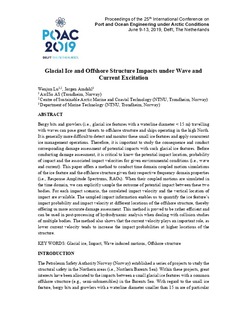| dc.contributor.author | Lu, Wenjun | |
| dc.contributor.author | Amdahl, Jørgen | |
| dc.date.accessioned | 2019-11-08T10:23:50Z | |
| dc.date.available | 2019-11-08T10:23:50Z | |
| dc.date.created | 2019-06-27T13:29:15Z | |
| dc.date.issued | 2019 | |
| dc.identifier.issn | 0376-6756 | |
| dc.identifier.uri | http://hdl.handle.net/11250/2627381 | |
| dc.description.abstract | Bergy bits and growlers (i.e., glacial ice features with a waterline diameter < 15 m) travelling with waves can pose great threats to offshore structure and ships operating in the high North. It is generally more difficult to detect and monitor these small ice features and apply concurrent ice management operations. Therefore, it is important to study the consequence and conduct corresponding damage assessment of potential impacts with such glacial ice features. Before conducting damage assessment, it is critical to know the potential impact location, probability of impact and the associated impact velocities for given environmental conditions (i.e., wave and current). This paper offers a method to conduct time domain coupled motion simulations of the ice feature and the offshore structure given their respective frequency domain properties (i.e., Response Amplitude Spectrums, RAOs). When their coupled motions are simulated in the time domain, we can explicitly sample the outcome of potential impact between these two bodies. For each impact scenario, the correlated impact velocity and the vertical location of impact are available. The sampled impact information enables us to quantify the ice feature’s impact probability and impact velocity at different locations of the offshore structure, thereby offering us more accurate damage assessment. This method is proved to be rather efficient and can be used in post-processing of hydrodynamic analysis when dealing with collision studies of multiple bodies. The method also shows that the current velocity plays an important role, as lower current velocity tends to increase the impact probabilities at higher locations of the structure. | nb_NO |
| dc.language.iso | eng | nb_NO |
| dc.publisher | Port and Ocean Engineering under Arctic Conditions, POAC | nb_NO |
| dc.title | Glacial Ice and Offshore Structure Impacts under Wave and Current Excitation | nb_NO |
| dc.type | Journal article | nb_NO |
| dc.type | Peer reviewed | nb_NO |
| dc.description.version | publishedVersion | nb_NO |
| dc.source.journal | Proceedings - International Conference on Port and Ocean Engineering under Arctic Conditions | nb_NO |
| dc.identifier.cristin | 1708313 | |
| dc.relation.project | Norges forskningsråd: 203471 | nb_NO |
| dc.description.localcode | © 2019 Port and Ocean Engineering under Arctic Conditions. Will be available at http://www.poac.com/PapersOnline.html | nb_NO |
| cristin.unitcode | 194,64,91,0 | |
| cristin.unitcode | 194,64,20,0 | |
| cristin.unitname | Institutt for bygg- og miljøteknikk | |
| cristin.unitname | Institutt for marin teknikk | |
| cristin.ispublished | true | |
| cristin.fulltext | original | |
| cristin.qualitycode | 1 | |
